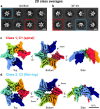Structural insights into ATP hydrolysis by the MoxR ATPase RavA and the LdcI-RavA cage-like complex
- PMID: 31992852
- PMCID: PMC6987120
- DOI: 10.1038/s42003-020-0772-0
Structural insights into ATP hydrolysis by the MoxR ATPase RavA and the LdcI-RavA cage-like complex
Abstract
The hexameric MoxR AAA+ ATPase RavA and the decameric lysine decarboxylase LdcI form a 3.3 MDa cage, proposed to assist assembly of specific respiratory complexes in E. coli. Here, we show that inside the LdcI-RavA cage, RavA hexamers adopt an asymmetric spiral conformation in which the nucleotide-free seam is constrained to two opposite orientations. Cryo-EM reconstructions of free RavA reveal two co-existing structural states: an asymmetric spiral, and a flat C2-symmetric closed ring characterised by two nucleotide-free seams. The closed ring RavA state bears close structural similarity to the pseudo two-fold symmetric crystal structure of the AAA+ unfoldase ClpX, suggesting a common ATPase mechanism. Based on these structures, and in light of the current knowledge regarding AAA+ ATPases, we propose different scenarios for the ATP hydrolysis cycle of free RavA and the LdcI-RavA cage-like complex, and extend the comparison to other AAA+ ATPases of clade 7.
Conflict of interest statement
The authors declare no competing interests.
Figures






Similar articles
-
Structural insights into the Escherichia coli lysine decarboxylases and molecular determinants of interaction with the AAA+ ATPase RavA.Sci Rep. 2016 Apr 15;6:24601. doi: 10.1038/srep24601. Sci Rep. 2016. PMID: 27080013 Free PMC article.
-
Structure of RavA MoxR AAA+ protein reveals the design principles of a molecular cage modulating the inducible lysine decarboxylase activity.Proc Natl Acad Sci U S A. 2010 Dec 28;107(52):22499-504. doi: 10.1073/pnas.1009092107. Epub 2010 Dec 9. Proc Natl Acad Sci U S A. 2010. PMID: 21148420 Free PMC article.
-
Assembly principles of a unique cage formed by hexameric and decameric E. coli proteins.Elife. 2014 Aug 5;3:e03653. doi: 10.7554/eLife.03653. Elife. 2014. PMID: 25097238 Free PMC article.
-
Stairway to translocation: AAA+ motor structures reveal the mechanisms of ATP-dependent substrate translocation.Protein Sci. 2020 Feb;29(2):407-419. doi: 10.1002/pro.3743. Epub 2019 Oct 17. Protein Sci. 2020. PMID: 31599052 Free PMC article. Review.
-
Spiraling in Control: Structures and Mechanisms of the Hsp104 Disaggregase.Cold Spring Harb Perspect Biol. 2019 Aug 1;11(8):a034033. doi: 10.1101/cshperspect.a034033. Cold Spring Harb Perspect Biol. 2019. PMID: 30745294 Free PMC article. Review.
Cited by
-
Translation Fidelity and Respiration Deficits in CLPP-Deficient Tissues: Mechanistic Insights from Mitochondrial Complexome Profiling.Int J Mol Sci. 2023 Dec 15;24(24):17503. doi: 10.3390/ijms242417503. Int J Mol Sci. 2023. PMID: 38139332 Free PMC article.
-
Mechanistic insights into sulfur source-driven physiological responses and metabolic reorganization in the fuel-biodesulfurizing Rhodococcus qingshengii IGTS8.Appl Environ Microbiol. 2023 Sep 28;89(9):e0082623. doi: 10.1128/aem.00826-23. Epub 2023 Sep 1. Appl Environ Microbiol. 2023. PMID: 37655899 Free PMC article.
-
Filamentation-driven peripheral clustering of the inducible lysine decarboxylase is crucial for E. coli acid stress response.Commun Biol. 2025 Aug 6;8(1):1168. doi: 10.1038/s42003-025-08616-5. Commun Biol. 2025. PMID: 40770054 Free PMC article.
-
Supramolecular assembly of the Escherichia coli LdcI upon acid stress.Proc Natl Acad Sci U S A. 2021 Jan 12;118(2):e2014383118. doi: 10.1073/pnas.2014383118. Proc Natl Acad Sci U S A. 2021. PMID: 33372137 Free PMC article.
-
RavA-ViaA antibiotic response is linked to Cpx and Zra2 envelope stress systems in Vibrio cholerae.Microbiol Spectr. 2023 Dec 12;11(6):e0173023. doi: 10.1128/spectrum.01730-23. Epub 2023 Oct 20. Microbiol Spectr. 2023. PMID: 37861314 Free PMC article.
References
MeSH terms
Substances
Grants and funding
LinkOut - more resources
Full Text Sources
Miscellaneous

